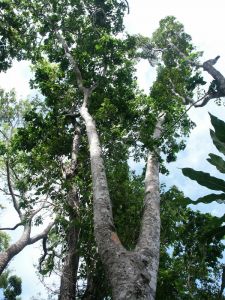Comparing arbuscular mycorrhizal diversity among different life stages of Intsia bijuga (Colebr.) Kuntze in Guam’s Limestone Forests

Guam’s tropical limestone forests are a vital component of the island’s environmental history. However, contemporary anthropogenic forces have reduced the habitat with less than 10% of the ecosystem remaining. A vital component of this ecosystem is interaction of large diameter canopy trees and fungi. Canopy trees supply fixed carbon to their mycorrhizal symbionts in exchange for limiting nutrients which can be distributed within the community through common mycorrhizal networks. Fungal symbionts also play important roles in pathogen protection, drought tolerance, and species richness within a community. In this study, we investigate mycorrhizal diversity in the roots of different life stages of Intsia bijuga (Ifit). The Ifit tree has seen a decline in large trees prior to WWII due to their highly valued wood by the native CHamoru people. We will use DNA primers specific to arbuscular mycorrhizal fungi (AMF) which are the major fungal symbiotes of tropical tree species. This is the first investigation comparing mycorrhizal diversity between different stages of Ifit. Results from this study can have implications for local forestry practices and resource management to continue its cultural relevance and maximize its success against habitat loss and climate change.
PROJECT DETAILS
FUNDED:
FY2020
PI:
Alexander Kerr
Professor of Marine Biology, University of Guam
Co-PI:
Charles “CJ” Paulino
Environmental Science, University of Guam

